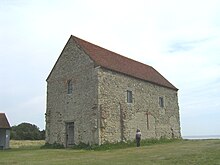Cedd
Cedd (also Cedde , Ceddi or Ceadwalla ; * around 620; † October 26, 664 ) was an Anglo-Saxon missionary , bishop and abbot . He is venerated as a saint .
Life
Cedd and his brothers Chad (Ceadda), Cynebill and Cælin were from Northumbria . Together with his brothers, he was trained as a monk and clergyman in the Lindisfarne monastery by Abbot Aidan (635-651) in the Irish-Scottish tradition. After Peada , the son and co-regent of King Penda , was baptized by Finan of Lindisfarne in 653 near Hadrian's Wall , the missionaries Cedd, Adda, Betti, and Diuma accompanied him from Northumbria to the central anchors .
In the same year (653) Cedd was sent from Oswiu to Essex with another priest at the request of King Sigeberht II of Essex , where he successfully proselytized. His successes were so great that he was ordained Bishop of the East Saxons by Finan on the occasion of a visit to Lindisfarne. After his return to Essex, he ordained other priests and deacons to support him and continued his work in the monastic mission centers of Ythancaestir and Tilaburg ( Tilbury ), which he founded. Ythancaestir was built on and out of the remains of the Roman fort Othona at Bradwell on Sea . The church of St. Peter-on-the-Wall , which is still in use today, was built by Cedd using the old defensive wall, from which it gets its name. Cedd did not have a permanent bishopric. London, which later became the center of the diocese, has not yet been mentioned in connection with Cedd.
Æthelwald von Deira provided land for the construction of a monastery in 658. Cedd and his brothers Chad and Cynebill founded the Northumbrian monastery Læstingaeu (Lastingham, Yorkshire ), which Cedd led as abbot in addition to his bishopric in Essex. Æthelwald of East Anglia was godfather of King Swithhelm of Essex when he was baptized by Bishop Cedd around 661 in Rendelsham, the royal seat of East Anglia.
In 664, Cedd participated as an interpreter at the Synod of Whitby , which was supposed to resolve existing differences between the Roman and Iro-Scottish rites. Cedd bowed to the decision of the synod and now represented the Roman rite. Cedd visited the monastery in Lastingham . There he died on October 26th of an epidemic that had broken out across Britain. He was initially buried in the monastery cemetery. After the monastery church was completed, he found his final resting place next to the altar.
Adoration
His feast day is celebrated on January 7th. In iconography , Cedd is shown as a bishop with a cup and crosier . The common representation with Saints Chad and Diuma is also common.
swell
- Beda Venerabilis : Historia ecclesiastica gentis Anglorum , Online in the Medieval Sourcebook (English)
literature
- DP Kirby, Alfred Smyth, Ann Williams (Eds.): A Biographical Dictionary of Dark Age Britain. England, Scotland and Wales c.500 - c.1050 , Routledge, 1991, ISBN 978-1-85264-047-7 .
- John Godfrey: The Church in Anglo-Saxon England , Cambridge University Press, 2009, ISBN 978-0-52110-904-8 .
Web links
- Cedd 1 in Prosopography of Anglo-Saxon England (PASE)
- Saint Cedd at Saints.SQPN.com
Individual evidence
- ↑ a b c Beda: HE 3.23
- ↑ Symeon of Durham : Historia ecclesiae Dunelmensis ("History of the Church of Durham") chap. 4 (around 1106)
- ↑ Beda: HE 3.21
- ↑ a b Beda: HE 3.22
- ^ John Godfrey: The Church in Anglo-Saxon England , Cambridge University Press, 2009, ISBN 978-0-52110-904-8 , pp. 110-111 and p. 168.
- ^ Richard Hoggett: The Archeology of the East Anglian Conversion (Anglo-Saxon Studies), Boydell & Brewer, 2010, ISBN 978-1843835950 , p. 26.
- ↑ Beda: HE 3.25-26
- ↑ Saint Cedd at Saints.SQPN.com (accessed May 17, 2011)
| predecessor | Office | successor |
|---|---|---|
| Mellitus |
Bishop of Essex to 654 - 664 |
Wina (Wine) |
| predecessor | Office | successor |
|---|---|---|
| - | Abbot of Lastingham 658 - 664 |
Chad |
| personal data | |
|---|---|
| SURNAME | Cedd |
| ALTERNATIVE NAMES | Cedde; Ceddi; Ceadwalla |
| BRIEF DESCRIPTION | Bishop of Essex, Abbot of Lastingham |
| DATE OF BIRTH | around 620 |
| DATE OF DEATH | October 26, 664 |
| Place of death | Lastingham |
